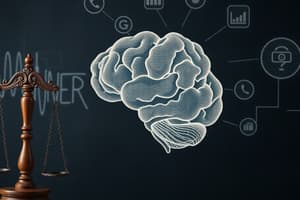Podcast
Questions and Answers
How does prototype theory primarily categorize new items?
How does prototype theory primarily categorize new items?
- By evaluating their similarity to multiple categories.
- By comparing them to specific stored examples.
- By assessing their frequency based on past experiences.
- By comparing them to an average or typical example. (correct)
What is the main difference between exemplar theory and prototype theory?
What is the main difference between exemplar theory and prototype theory?
- Exemplar theory requires comparison with a single best example, while prototype theory compares with multiple examples.
- Prototype theory relies on a single average, whereas exemplar theory utilizes specific stored examples. (correct)
- Exemplar theory is based on the frequency of items, while prototype theory is based on emotional responses.
- Exemplar theory uses abstract categories, while prototype theory uses defined categories.
Which bias leads to overestimating the likelihood of rare events based on memory availability?
Which bias leads to overestimating the likelihood of rare events based on memory availability?
- Framing effects
- Availability bias (correct)
- Conjunction fallacy
- Representativeness heuristic
What typically happens in the conjunction fallacy?
What typically happens in the conjunction fallacy?
What describes the concept of framing effects in decision-making?
What describes the concept of framing effects in decision-making?
How do people typically behave in situations involving risk and potential gains?
How do people typically behave in situations involving risk and potential gains?
What is often a result of human misinterpretation of probabilities?
What is often a result of human misinterpretation of probabilities?
What primarily guides human decision-making regarding potential outcomes?
What primarily guides human decision-making regarding potential outcomes?
What is the main focus of the representativeness heuristic in decision making?
What is the main focus of the representativeness heuristic in decision making?
Flashcards
Concepts
Concepts
Mental representations categorizing shared features of related objects, events, or stimuli.
Prototype
Prototype
The most typical example of a category, used as a reference point.
Exemplar Theory
Exemplar Theory
Categorizing by comparing to specific examples stored in memory.
Availability Bias
Availability Bias
Signup and view all the flashcards
Conjunction Fallacy
Conjunction Fallacy
Signup and view all the flashcards
Representativeness Heuristic
Representativeness Heuristic
Signup and view all the flashcards
Framing Effects
Framing Effects
Signup and view all the flashcards
Probability
Probability
Signup and view all the flashcards
Risky Behavior
Risky Behavior
Signup and view all the flashcards
Decision Making & Probability
Decision Making & Probability
Signup and view all the flashcards
Study Notes
Concepts and Categorization
- Concepts are mental representations categorizing shared features of related objects, events, or stimuli.
- A prototype is the most typical example of a category, a reference point for comparison.
- Exemplar theory suggests categorizing new stimuli by comparing them with specific examples stored in memory.
- Prototype theory compares new items to an idealized average or best example.
- Exemplar theory involves comparing new items to multiple stored examples, enhancing flexibility.
Heuristics and Biases in Judgment
- Availability bias: Judging event frequency/likelihood based on how easily examples come to mind (memorable events seem more common).
- Conjunction fallacy: Incorrectly believing specific conditions are more probable than a general condition.
- Representativeness heuristic: Judging probability based on similarity to a prototype, neglecting base rates.
- Framing effects: How information is presented (e.g., success rate vs. failure rate) influences decisions.
- Prospect theory: Describes how people perceive and value potential gains and losses, which is usually influenced by loss aversion.
Probability and Decision Making
- Probability measures the likelihood of an event.
- People often misinterpret probabilities, leading to irrational choices.
- People are often illogical with probabilities, overestimating rare events and underestimating common events, leading to biases like the availability bias and conjunction fallacy..
- People tend to be risk-averse when gaining something; but risk-seeking when avoiding a loss, focusing on immediate effects over long-term consequences.
Risky Behavior and Future Consequences
- Loss aversion: Emotional impact of a loss outweighs pleasure of an equivalent gain; leads to riskier behavior to avoid losses.
- Optimism bias: Overestimating positive outcomes and underestimating negative ones, leading to a favorable view of personal risk.
Studying That Suits You
Use AI to generate personalized quizzes and flashcards to suit your learning preferences.




